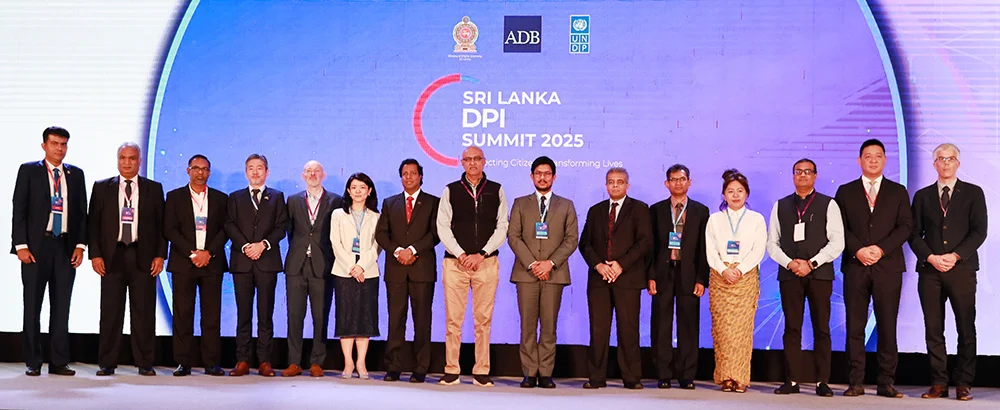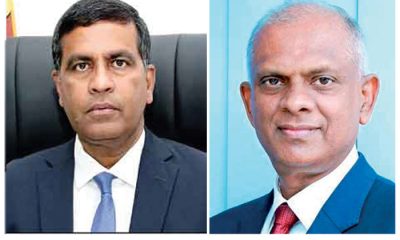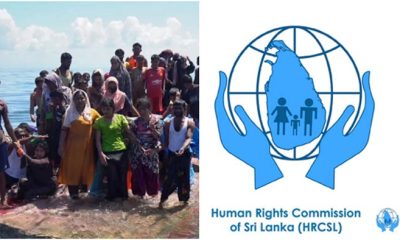Business
Stock market overcome by bearish inertia; turnover drops to Rs. 6.3 billion

By Hiran H. Senevirathne
Stock market activities were extremely bearish yesterday due to global market conditions, especially with US new tariff policies coming into play, and worries that the forthcoming budget would likely impact the corporate sector negatively, market analysts said.
Amid those developments both indices moved downwards. The All Share Price Index significantly dropped by 500 points, while S and P SL20 declined by 175.6 points. Turnover stood at Rs 6.3 billion with six crossings. Those crossings were reported in Ceylinco Insurance, which crossed 294,000 shares to the tune of Rs 940 million and its shares traded at Rs 3200, TJ Lanka 1 million shares crossed to the tune of Rs 55.6 million; its shares traded at Rs 55.50, CCS 450,000 shares crossed for Rs 41.8 million; its shares traded at Rs 93, HNB 100,000 shares crossed for Rs 33.4 million; its shares traded at Rs 334, JKH 1 million shares crossed to the tune of Rs 22.1 million; its shares traded at Rs 22.10 and JAT Holdings 729,000 shares crossed for Rs 20.1 million; its shares traded at Rs 2750.
In the retail market top six companies that mainly contributed to turnover were; Browns Investments Rs 541 million (62.2 million shares traded), JKH Rs 490 million (22.1 million shares traded), Ceylinco Insurance Rs 316 million (95000 shares traded), TJ Lanka Rs 197 million (3.5 million shares traded), HNB Rs 191 million (567,000 shares traded) and Commercial Bank Rs 171 million (1.1 million shares traded). During the day 241 million share volumes changed hands in 41700 transactions. It is said that the banking and financial sector performed well, especially Ceylinco Insurance, while the manufacturing sector also gained with JKH and TJ Lanka.
Yesterday, the rupee was quoted at Rs 299.75/95 to the US dollar in the spot market, weaker from Rs 299.60/75 to the US dollar Monday, dealers said, while bond yields were broadly steady.
A bond maturing on 15.09.2027 was quoted at 9.80/90 percent, up from 9.80/85 percent. A bond maturing on 15.02.2028 was quoted at 10.16/20 percent, up from 10.10/20 percent. A bond maturing on 01.07.2028 was quoted at 10.39/41 percent. A bond maturing on 15.09.2029 was quoted at 10.85/90 percent, up from 10.75/85 percent. A bond maturing on 15.10.2030 was quoted flat at 11.25/30 percent.
Business
UNDP, ADB pledge support to SL on its public digital journey at key summit

Privacy challenges in the rollout of digital ID scheme also come into focus
By Sanath Nanayakkare
Key officials of the United Nations Development Programme (UNDP) and Asian Development Bank taking part in the Sri Lanka Digital Public Infrastructure (DPI) Summit in Colombo said yesterday that they would support Sri Lanka to become a digital economy powerhouse in the region.
The Ministry of Digital Economy had put together this two-day summit in partnership with the UNDP in Sri Lanka, the ADB and key collaborators including Huawei.
The Summit’s first session underscored the critical role of DPI as an enabler in building the country’s digital economy with universal DPI safeguards embedded to ensure safety and inclusion.
With transparency, safety and inclusion prioritized, the Summit 2025 brought together global leaders, key experts, innovators, and stakeholders from diverse sectors for dialogue and action on existing challenges and opportunities around DPI to accelerate economic growth and progress on the Sustainable Development Goals.
Key participants in the opening session included: Eranga Weeraratne, Deputy Minister of Digital Economy; Dr. Hans Wijayasuriya, Chief Advisor to the President on Digital Economy; Antonio Zaballos, Director, Digital Sector Office, ADB; Azusa Kubota, Resident Representative, UNDP Sri Lanka; Srikanth Nadhamuni, Founder CTO, Aadhaar; Keyzom Ngodup Massally, Head of Digital & AI Programmes, UNDP Chief Digital Office; and other high-level representations from the public and private sectors.
Eranga Weeraratne, Deputy Minister of Digital Economy stated that the government envisions Sri Lanka’s digital economy to reach $15 billion by 2030.
The eminent speakers emphasized the importance of public-private partnerships and cross-sector collaboration in successfully designing and implementing DPI at population-scale, particularly with the necessary safeguards to anticipate and mitigate risks.
Dr. Hans Wijayasuriya, Chief Advisor to the President on Digital Economy said, “The primacy given to Digital Economy Acceleration by the Government of Sri Lanka is exemplified by the creation of the Digital Economy Ministry under the direct purview of His Excellency the President. The Ministry is committed to building a robust digital economy that benefits all citizens. Our goal is to use digital transformation to accelerate economic growth, achieve leapfrog elevation of Citizen and Business Services and eliminate asymmetries across the socio-economic pyramid. The establishment, and accelerated adoption of DPIs is a foundational pillar of this strategy. We are confident that the DPI summit will bring together the effort and commitment of likeminded stakeholders to support the achievement of Sri Lanka’s Digital Economy ambitions.”
Dr. Hans said on a lighter note that when he was in the telco industry , his main focus was ‘customer experience’ and now in his new capacity , his focus would be on ‘citizen experience’.
Takafumi Kadono, ADB Country Director for Sri Lanka commented, “Digital Public Infrastructure is an essential enabler of Digital Transformation. As our economies and societies digitalize, Government is called upon to provide the high-speed digital rails and competencies that this requires. We at ADB look forward to supporting Sri Lanka’s ambitions to become a Digital Economy Powerhouse.”
The ‘Transforming Local Administrative Data Collection Systems for SDG Acceleration in Sri Lanka’ project was highlighted during the event. Led by the Government of Sri Lanka, implemented by UNDP Sri Lanka and the World Health Organization (WHO) in SriLanka, and funded by the UN Sri Lanka SDG Fund, the project demonstrates Sri Lanka’s commitment to leveraging DPI for improved service delivery, economic efficiency, and citizen empowerment as a first mover country of the 50-in-5 global campaign.
Speaking at the Summit, Azusa Kubota, Resident Representative, UNDP in Sri Lanka noted, “Digital platforms can contribute greatly to building trust between government institutions and citizens by enhancing accessibility, transparency, safety, and responsiveness of services. As part of our commitment to advancing accountable institutions for SDGs attainment, UNDP, globally and locally here in Sri Lanka, supports designing national policy frameworks, building capabilities for digital adoption, as well as introducing tangible digital solutions for improved public service delivery. As Sri Lanka spearheads digitalization, this inaugural Summit is a pivotal step in Sri Lanka’s Digital journey.”
Keyzom Ngodup Massally, Head of Digital & AI Programmes, UNDP Chief Digital Office notably spoke about the Kenyan case when it came to digitalization of its national ID programme, and gave her insights on the robust privacy framework and universal safeguards that would be critical in the whole digitalization exercise.
A landmark ruling by the High Court of Kenya in 2021, concluded that the rollout of a country-wide biometric ID scheme was illegal. Kenya’s digital identity rollout was paused for the third time by the country’s High Court in July 2024, pending the outcome of a constitutional challenge.
Business
SDC and partners to impement initiatives to bolster Sustainability Standards and Reporting of the Sri Lankan apparel and textile sector

In support of its efforts towards promoting grater participation of the private sector in Sri Lanka’s inclusive and sustainable growith trajectory aligned with the Sustainable Development Goals (SDGs), the Sustainable Development Council recently facilitated a mission from the Global Reporting Initiative (GRI) – South Asia Network with the aim of strengthening the capacities of Sri Lankan businesses in the Textile & Apparel sector on sustainability standards and certification, risk management and reporting based on the globally accepted GRI frameworks,
Sri Lanka holds a key position in the global fashion industry supply chain as an ethical sourcing destination for apparel and fashion. However, against the growing global demands for stricter policies and practices assuring higher environmental and social safeguards, Sri Lankan businesses in the apparel and textile sector will need to adopt new initiatives to improve productivity, reduce environmental impact to continue to retain its prominent and respected position in the global apparel supply chain and push into new markets which are demanding and ready to pay a premium for ethically and sustainably manufactured apparel products. According to Market Research Future (2023), the global market for sustainable textiles is expected to grow at a compound annual growth rate of 12.5% between 2022 and 2030, reaching nearly USD 69.5 billion in 2030.
GRI is an independent international organization providing standards, tools and training to organizations of all sizes to harness the skills, capabilities and data to create sustainable, long-term value and unlock positive change. GRI standards are among the world’s most widely accepted sustainability reporting framework. Headquartered in Amsterdam, Netherlands, GRI has a network of five regional networks through which it supports organizations and stakeholders worldwide.
Based on the discussions with SDC held through 2024, Sri Lanka was included in the ‘Improving Transparency for Sustainable Business (ITSB) Programme’ to be implemented by GRI in India, Bangladesh and Sri Lanka with the support of the Swedish International Development Cooperation Agency (SIDA). The Programme aims to build the capacity of businesses to meet market and regulatory requirements while improving practices in labor, economic impact and tax and sustainability reporting among others.
During the mission, extensive consultations were held with SDC and its partner agencies from government, the Ministry of Industries and the Export Development Board and industry stakeholders represented through the Joint Apparel Association Forum (JAAF), Sri Lanka Apparel Exporters Association and ESG Professionals Association to agree on priority interventions for Sri Lanka through 2025 to 2027.
Accordingly, capacity building sessions would be conducted for 100 apparel and textile sector companies in Sri Lanka based on an assessment of current capacities on materiality assessments and impact reporting during 2025. As next step, it is expected to create digital reporting platforms to integrate SMEs in the textile and apparel sector into impact reporting practices through simplified approaches.
The above interventions are expected to strengthen the ability of Sri Lankan businesses in the apparel and textile sector to create value for employees, customers, communities and the environment whilst also enhancing their ability to access new market opportunities in the fashion industry.
Business
Superior quality feed boosts bottom line

Sustainability, poultry modernization, feed costs optimization and animal nutrition took center stage at the U.S. Soybean Export Council (USSEC)’s signature Chickenomics event in Kathmandu, Nepal.
South Asia’s poultry industry continues to show a preference for U.S. Soy, using it as a key feed ingredient. With its high energy and protein levels, U.S. Soy consistently provides superior quality while lowering feed costs and improving profitability. This event comes at an opportune time as U.S. Soy’s prices are competitive in the global marketplace.
U.S. Soy has achieved some significant milestones in the region in recent months. Pakistan reopened trade after a two-year pause easing market access. In Nepal, key poultry producer Valley Group has signed on to use the “Fed with Sustainable U.S. Soy” label on its packaging, underscoring the value it places on sustainability. According to data from USDA, U.S. soybean imports to Bangladesh are up by 36.2% compared to last year. India also has 111,500 MMT of outstanding sales for U.S. soybean oil reflecting U.S. Soy’s growing presence in the region.
Commenting on this surge in U.S. Soy imports, Kevin Roepke, USSEC’s Regional Director for South Asia and Sub-Saharan Africa (SAASSA) added, “2025 has started strong for U.S. Soy. We are grateful for our customers across the region who recognize the potential that U.S. Soy holds in advancing the region’s food and nutrition security. We are confident that this will be a turning point in strengthening our partnerships with the industry.”
-

 News4 days ago
News4 days agoNew Bangalore-Jaffna flights in the works
-

 Features6 days ago
Features6 days agoA singular modern Lankan mentor – Part I
-

 News2 days ago
News2 days agoCID questions top official over releasing of 323 containers
-

 News4 days ago
News4 days agoCardinal says ‘dark forces’ behind Easter bombs will soon be exposed
-

 News4 days ago
News4 days agoHRCL reports on Rohingya asylum seekers
-

 Opinion6 days ago
Opinion6 days agoA New Approach to Rabies Eradication in Sri Lanka
-

 Business6 days ago
Business6 days agoA record USD 350.8 million in worker remittances in 2024
-

 Features3 days ago
Features3 days agoA singular modern Lankan mentor – Part II











